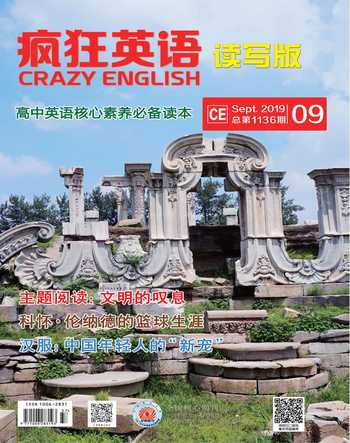Traditional Han Fu enjoys revival among young Chinese 汉服:中国年轻人的“新宠”
2019-09-10彭向梅
彭向梅
海詞积累
1. a flowing long robe 飘逸的长袍
2. beaded floral embroidery 串珠绣花
3. metro n. 地铁
4. boom v. 繁荣昌盛; 迅速发展
5. Han ethnic majority 汉族人
6. patriotism n. 爱国主义
7. debut v. 初次登台
8. tassel n. 流苏
9. ornament n. 装饰品
Dressed in a flowing long robe decorated with beaded floral embroidery from ancient time, stylist Xiao Hang looks like she came from a time machine as she walks across the Beijing metro, attracting many glances. China has embraced Western fashion and futuristic technology as its economy boomed in recent decades, but a growing number of young people like Xiao are looking to the past for their choices and wearing traditional “Han Fu”.
These historic costumes of the Han ethnic majority are enjoying a renaissance because the government is promoting traditional culture to boost patriotism and national identity. Period dramas have also contributed to the increasing interest for traditional Chinese clothing-The Story of Minglan, a TV series set in the Song Dynasty, attracted more than 400 million viewers in three days when it debuted earlier this year.
There is no accurate definition of what counts as Han Fu since each Han-dominated dynasty had its own style, but the outfits are characterized by loose, flowing robes that drape around the body, with sleeves that hang down to the knees.
A complete Han Fu garment developed in time with addition of other parts of clothing. Now, it is considered that it consists of several pieces of clothing: Yi-which is any open cross-collar garment and is worn by both men and women; Pao-any closed full-body garment, it is worn only by men; Ru-open shirt with cross-collar; Shan-open cross-collar shirt or jacket which is worn over the Yi; Qun or Chang-a type of skirt which is worn by both women and men and Ku-a type of trousers or pants. It is also considered traditional to decorate Han Fu with tassels and jade pendants(坠饰) or various ornaments hung from the belt or sash, which are known as Pei. Hats for men and hairpieces for women could also be traditionally worn in combination with Han Fu. This headwear also marked profession or social rank.
Zhou Yingxi, a girl wearing Han Fu everyday, said it's nice to see more and more people wearing Han Fu. While for some people, it's just a bit strange to wear traditional Han Fu in modern time.
Reading Check
(2019·江苏卷)请阅读下面文字,并按照要求用英语写一篇150词左右的文章。
Li Jiang:Have you heard this?A group of exchange students from the UK are visiting our school next month.
Su Hua:Yes,I have. Some are already recommending the traditional Chinese dress for the welcome ceremony.
Li Jiang:But it seems people have different opinions.
Su Hua:What do you think?
Li Jiang:I think it's a good idea. It's an opportunity to make the Chinese culture better known to international students.
Su Hua:I agree. But we don't have to dress that way. That's not our daily style. Besides, it's not very convenient.
Li Jiang:You see. It's the Chinese culture that the British friends are coming for. Just the right occasion.
Su Hua:I prefer the school uniform. It's nice. It's also a better display of our school culture.
写作内容:
1. 用约30个词概括上述信息的主要内容;
2. 在上述场合,你是否倾向穿中国传统服装?请说明理由(不少于两点)。
Language Study
Sentence for writing
that引导定语从句
There is no accurate definition of what counts as Han Fu since each Han-dominated dynasty had its own style, but the outfits are characterized by loose, flowing robes that drape around the body, with sleeves that hang down to the knees. 汉服的确切定义并不统一,因为每个汉族统治的王朝都有自己的风格,但其特点是宽松、飘逸的披身长袍和长至膝盖的袖子。
【点石成金】本句中第一个that引导定语从句,先行词为robes; 第二个that同为定语从句,先行词为sleeves。
【仿寫】这是我见过的最激动人心的足球比赛之一。
